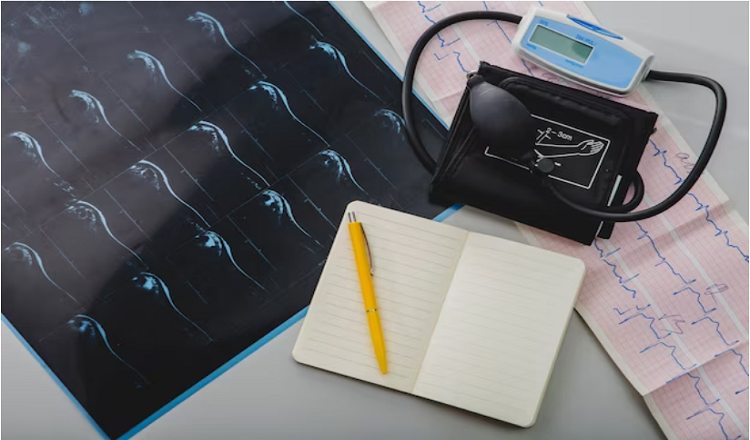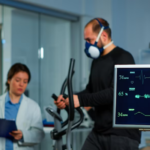
In this blog post about electrocardiography (ECG), the fascinating realm of heart health through electrical impulses will be examined. ECGs are frequently used, but do you understand what they are and how they work? We’ll go into detail regarding an ECG’s definition, brief history, and importance for monitoring heart health.
Electrocardiography, also known as ECG or EKG, is a non-invasive diagnostic technique that evaluates the electrical activity of the heart. During this brief and painless examination, electrodes are attached to the skin of the chest, arms, and legs in order to detect the electrical signals that control the heart’s rhythm and activity. But where did this technology come from? Willem Einthoven, a Dutch scientist, discovered the ECG for the first time in the early 20th century. Since then, it has developed into a vital instrument for detecting and monitoring a number of heart problems.
So why is ECG important? The heart is one of our body’s most vital organs, and any irregularities in its normal operation could have disastrous effects. ECG may spot a variety of heart conditions, such as arrhythmias, heart attacks, and heart disease, allowing doctors to treat patients quickly and efficiently. We may put our cardiovascular health first by working to understand the ECG’s operation and its purpose in keeping an eye on our heart health. Let’s investigate the realm of ECG and see if it can aid in our efforts to maintain heart health.
Summary of the Heart
The heart, which pumps blood throughout the body, is a vital organ. It is roughly the size of a fist, located between the lungs, and its lower tip points in the direction of the left hip. The four chambers of the heart are the right and left ventricles, right and left atria, and right and left atrium. The atria take in blood from the body and lungs as the ventricles pump blood to other body areas. The heart has four additional valves that allow for sufficient blood flow through its chambers.
The heart’s function is to pump oxygen- and nutrient-rich blood to all of the body’s organs and tissues while expelling waste products from the body. The heart has the ability to do this because to its sophisticated blood channel network, or circulatory system. Blood is transported to and from the heart by the arteries, veins, and capillaries that make up the circulatory system. While arteries carry oxygen-rich blood, veins return oxygen-depleted blood to the heart for reoxygenation. The blood and human tissues exchange nutrients and waste materials in the smallest blood vessels, known as capillaries. Understanding the heart’s architecture, mechanics, and function in connection to the circulatory system is essential for maintaining optimal heart health.
How ECG Works
Electrocardiography (ECG) measures the electrical activity of the heart, which controls its rhythm and function. The heart’s electrical conduction system, which generates and transmits the electrical impulses that cause the heart to contract and relax, is made up of specialised cells. These impulses create a waveform pattern, which the ECG equipment records.
When an ECG is performed, electrodes are placed on the skin of the chest, arms, and legs to capture the electrical signals generated by the heart. The electrodes are connected to the ECG equipment, which amplifies and records the electrical activity of the heart. The ECG waveform is made up of several waves, including the P wave, QRS complex, and T wave. These waves show the electrical activity of multiple heart areas throughout a single heartbeat. Understanding the ECG waveform pattern and its variations is crucial for identifying any anomalies in the heart’s electrical activity.
Common Conditions Found by ECG
Electrocardiography (ECG), a non-invasive diagnostic tool, can detect a variety of cardiac illnesses by examining the electrical activity of the heart. Atrial fibrillation, which is typified by an erratic and fast heartbeat, is usually diagnosed using an ECG. An ECG can also detect heart attacks, which occur when blood flow to the heart is restricted and destroys the heart muscle. Additionally, coronary artery disease, which is caused by plaque buildup in the arteries that provide blood to the heart, can be detected using an ECG. An ECG can also identify cardiac arrhythmias, which are abnormal heartbeats. These anomalies can be immediately detected and addressed using ECG, potentially reducing complications and improving results.
Preparing for an ECG
If the patient is ready for the ECG, they will probably feel more at ease and the readings will be accurate. During an ECG, electrodes are positioned on the patient’s chest, arms, and legs. The patient is asked to keep still while the apparatus records the electrical activity of their heart. The procedure normally just takes a few minutes and is quick and painless.
To prepare for an ECG, patients should refrain from applying lotions or oils to their skin prior to the test, wear loose clothing that allows easy access to their chest, and let their doctor know about any medications they are taking. Along with other patients with special requirements, pregnant patients or those with mobility issues could need additional accommodations or modifications to the procedure. It’s crucial to follow any suggestions or directions given by the doctor or other healthcare provider if you want to have a successful and comfortable ECG experience.
ECG interpretation
“ECG interpretation” is the process of examining the heart’s electrical activity as it is captured by an ECG machine. A complete assessment of the heart’s electrical activity is provided in the ECG report, which is also used to diagnose a number of cardiac conditions.
Normal ECG readings show a regular heartbeat and a consistent waveform pattern. An abnormal ECG reading, which may show irregularities in the heart’s electrical activity, may be a sign of a cardiac problem. Understanding the results of an ECG report requires knowledge of the ECG waveform pattern and its fluctuations, as well as the patient’s medical history and any symptoms they may be displaying. A medical expert or cardiologist can evaluate the results of an ECG, provide an accurate diagnosis, and recommend any necessary therapies or procedures.
Improvement of ECG Technology
Modern ECG technology has made heart health monitoring simpler and more practical than ever. With the use of wireless ECG monitoring, patients can have the electrical activity of their hearts remotely recorded without the need for physical connections or electrodes. Two examples of wearable ECG equipment that are gaining popularity and that track heart activity continuously are smartwatches and fitness trackers.
It is anticipated that future developments in ECG technology would improve the accuracy and usefulness of heart health monitoring. The incorporation of artificial intelligence (AI) to aid in the interpretation of ECG results and the development of more advanced wearable devices that can simultaneously monitor several vital signs are examples of these developments. As ECG technology develops, we might soon see a revolution in how we monitor and treat heart health.
Conclusion
Therefore, electrocardiography (ECG), which records the electrical activity of the heart, is an essential technique for determining heart health. Regular ECG checks can help detect a variety of heart conditions, such as atrial fibrillation, heart attacks, and coronary artery disease, which can lead to speedier recovery times.
Particularly if they have risk factors like high blood pressure or a family history of heart disease, people should take their heart health seriously and get regular ECG testing. By maintaining a heart-healthy lifestyle that includes regular exercise, a balanced diet, and quitting smoking, people can reduce their risk of developing heart disease and other related issues.
Monitoring heart health is now easier than ever thanks to modern advancements in ECG technology, such as wireless ECG monitoring and wearable devices that allow continuous cardiac monitoring. These developments could improve the early detection of heart illness and lead to better health outcomes.
In conclusion, maintaining our heart health should be a top priority, and having regular ECG checks is necessary to achieve this.
Read More You May Like:
- Electroconvulsive Therapy (ECT): A Guide to the Controversial Treatment for Mental Illness
- Electroencephalography (EEG): The Brain-Monitoring Technology and Its Applications
- Electrostimulation Therapy: Improving Muscle Strength and Function for Patients
- Electrotherapy for Pain Relief: A Comprehensive Guide
- Medical Imaging: How Electromagnetic Waves Are Used for Diagnosis and Treatment








